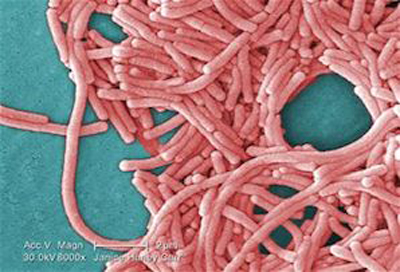Legionnaires’ Disease (LD) is an infection caused by Legionella pneumophila bacteria. As the name of the bacteria suggests, the infection (also called legionellosis) is in the lungs and causes pneumonia, generally a severe form that is often fatal.

An article in the November* issue of Emerging Infectious Diseases (a CDC publication) looks at Legionnaires’ Disease incidence and risk factors in New York City from 2002 to 2012. (Data from 2013 and 2014 was not used for this study because it takes time for all of the data for a year to be compiled and confirmed.)
Here are the main points:
- Incidence of Legionnaires’ Disease increased over 230%;
- The highest incidence of community-acquired LD occurred in the highest poverty areas;
- People working in transportation, repair, protective services, cleaning, or construction appeared to be at greater risk of contracting LD than the general working population;
- Over 88% of LD case-patients in this study had at least one underlying medical condition that is recognized as a risk factor, including diabetes (34%).
This is valuable research, and more should be done to determine why low-income areas are hardest hit:
“It remains unclear whether the disparities in legionellosis incidence arise from differences in neighborhood environments, such as building construction and maintenance; from differences in access to preventive health care services that could potentially improve conditions such as diabetes; or from differences in the population itself, such as increased levels of diabetes and other host risk factors” (excerpt from the article).
Legionnaires’ Disease that is not linked to a hospital or nursing home is considered “community acquired” as opposed to “health care facility-associated” LD. In this study, for a case of LD to be considered “definitely” caused by water at a health care facility, the patient had to be a resident of a hospital or nursing home for the length of the incubation period. Most LD cases analyzed in this study were community-acquired (88%). Only 7% were “definitely” health care facility-acquired, as defined by the study.
One interesting finding is that transportation workers are a high risk group. Legionnaires’ Disease is contracted by breathing in water mist contaminated with Legionella bacteria. Possible reasons for transportation workers are more at risk could be: 1) drivers of commercial vehicles (buses, semitrailer trucks, airplanes) are exposed to air conditioning for lengthy periods of time; and 2) workers who wash these vehicles are exposed to water mist every workday. In addition, recent research out of Arizona State University found that Legionella bacteria can live in some brands of windshield washer fluid. The reservoirs that hold it are warmed by the engine, making it a perfect growing environment.
*Farnham A, Alleyne L, Cimini D, Balter S. Legionnaires’ disease incidence and risk factors, New York, New York, USA, 2002–2011. Emerg Infect Dis [Internet]. 2014 Nov. http://dx.doi.org/10.3201/eid2011.131872
Fred Pritzker promotes water safety.